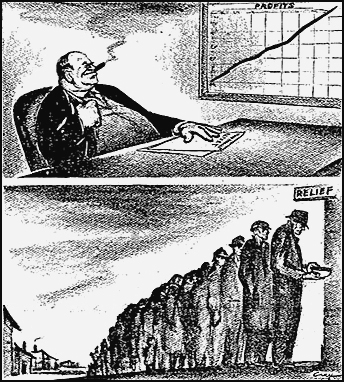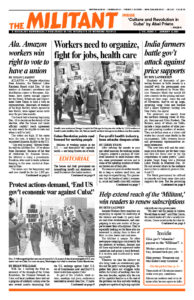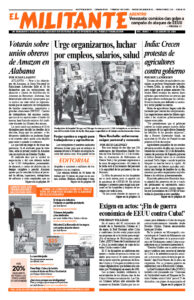
The Spanish edition of Capitalism’s World Disorder: Working Class Politics at the Millennium by Jack Barnes, national secretary of the Socialist Workers Party, is one of Pathfinder’s Books of the Month for December. The book explains the economic and political developments that led to the decadeslong downturn in the arc of capitalist development we’ve lived through. This excerpt is from the chapter “So Far From God, So Close to Orange County: The Deflationary Drag of Finance Capital.” It helps explain the underlying forces, accelerated by the capitalist rulers’ responses to the pandemic, at work in today’s global capitalist economic crisis. Copyright © 1999 by Pathfinder Press. Reprinted by permission.
BY JACK BARNES
The world capitalist economy has entered a long-term deflationary crisis, a contraction that cannot be fundamentally reversed by the ups and downs of the business cycle. With their profit rates under long-term pressure, the capitalists are in their “lean and mean” period, their “just-on-time” period, their “downsizing,” “computerizing,” and “de-layering” period. They are laying off workers and other employees, speeding up production, and raking in short-term cash in the bargain.
But the one thing the capitalists are not doing, and are incapable of doing, is expanding productive capacity to anywhere near the degree they need to fuel another gigantic boom, set industrial profit rates on a long-term upward course, and accelerate capital accumulation. Even as capitalists temporarily boost their returns by cutting costs and taking a bigger slice of market share away from their rivals, the long-run profit expectations of capital are such that they are still not investing in new plant and equipment that draws more and more workers into expanded production.
The money that is going into new equipment goes largely into ways to make us work faster to produce more with fewer co-workers. That does not expand productive capacity, however. It intensifies speedup and extends the workweek. But that alone does not create the basis for the rising profit rates and capital accumulation that marked the post-World War II capitalist boom until it began running out of steam by the early 1970s.
In fact, instead of issuing stock to finance expansion — the classic source of “capital formation” extolled in standard economics textbooks — U.S. corporations for most of the 1980s and 1990s have actually bought more previously offered stock from each other than they have issued in new shares. Capitalists have also issued large quantities of high-interest corporate bonds — gone deep into debt, in other words — to finance takeovers and buyouts.
So, the world’s propertied families have been fighting among themselves more and more to use credit to corner a bigger cut of the surplus value they collectively squeeze from working people. They have been blowing up great balloons of debt. But ever since the 1987 stock market panic, and at an accelerated pace since the onset of world depression conditions at the opening of the 1990s, the capitalists have been plagued by the problem that first one balloon, then another, and then yet another begins to deflate. And they have no way of knowing which balloon will go next until they start hearing the “whoosh,” and by then it is often too late. …
With returns on investments in capacity-expanding plant and equipment under pressure since the mid-1970s, owners of capital have not only been cost cutting; the holders of paper have been borrowing larger and larger amounts to buy and sell various forms of paper securities at a profit. They blew up a giant balloon of debt in Orange County over a period of years; the bondholders thought they had died and gone to heaven. Then the balloon began to deflate, as they learned the hard way that interest rates go up as well as down. When the balloon international bankers had inflated in Mexico in the 1980s began to collapse, the bondholders stepped in and blew it back up for a while. But in Orange County, the more local officials borrowed to make a killing using public funds to gamble with bond merchants, the greater their vulnerability became. Earlier this year, when rates started rising and low-interest bond issues were suddenly no longer available, the moment of truth arrived.
Now the capitalists and their public representatives — and not just in Mexico or Orange County — have been given another warning of the long-run possibilities of an uncontrollable deflation.
Over the past couple of decades, upturns in the business cycle have relied on floating large amounts of fictitious capital — ballooning debt and other paper values. The capitalists are now paying the piper for the lack of sufficient economic growth during that period to keep rolling over the loans.
The financial press has a term for this explosive process; they call it “de-leveraging.” …
Wall Street has already offered up Orange County’s treasurer as a scapegoat. But their bottom line is going to be that it is working people like us who are really to blame. If we would accept fewer schools and hospitals, if we would agree to pay higher tuition, if we would demand less public transportation, if “illegals” could be kept off the public rolls, then there would not be so much pressure on poor fund managers to pour billions into high-risk investments. And public workers are already the first to suffer layoffs in Orange County.
Municipal bonds, together with U.S. Treasury bills, are the prerogative of the very rich. … And written on each and every one of these pieces of paper are the words “Full faith and credit.” That means the only collateral they are ultimately backed up by is the “full faith and credit” of the government or agency that issued them. The “faith” derives from the guarantee to the wealthy bond-holders that they are always at the head of the line to be paid out of taxes and other revenues. First comes the interest — then, if there is anything left, the schools, roads, hospitals, and payroll. It is never the other way around.
No cuts! That is the bondholders’ slogan too!
And since governments produce no wealth, we are the ones the debtors come to in order to demonstrate their “full faith and credit.” The blood money is squeezed from us.

